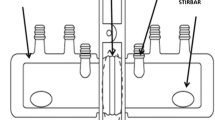Abstract
Permeability coefficient (P) expressed as distance per unit time has been commonly interpreted to represent the velocity of drug movement across a heterogeneous medium such as skin and intestinal epithelium. The basis of such an interpretation is questioned on several grounds. For example, the basic assumption for calculatingP (as defined conventionally) according to the Fick's law of diffusion requires the entire medium to be homogeneous and rate-limiting in transport. The theoretical basis of the widely used total resistance or resistance additivity concept is reviewed. Such a concept is shown to be applicable to the study of total transit time across the medium but may not be applicable to the study of steady-state flux or absorption across the medium under normal conditions. Based on the diffusional, compartmental, absorptive clearance or carrier-mediated-transport analysis it is shown that only the first transport resistance from the bulk medium across the surface (such as cellular membranes_ of the permeation medium (such as a cell or a tissue) is usually the deciding factor in drug transport or absorption. Resistances on the other side of the surface barrier usually only affect the drug accumulation vs. time profile in the medium, but not the steady-state flux or absorption. The role of unstirred water layer adjacent to the internal capillary wall is postulated to play an important role in causing the blood-flow dependency in absorption, a phenomenon that cannot be rationalized by the conventional effective permeability concept. The conventional concept of sink conditions on the serosal side is questioned. The present analysis further supports the use of the absorptive or transport clearance concept in absorption or transport study. Effective permeability is regarded as a mathematical operator for transport across a barrier or a tissue, and may be unrelated to the Fick's law of diffusion under most conditions. The velocity unit forP is regarded simply as a “collapsed” unit based on the absorptive or transport clearance per unit gross surface area. It is hoped that this commentary will stimulate further research and discussions in this general area of drug transport and absorption. It appears thatthere is a need to experimentally confirm the total resistance theory in biological systems.
Similar content being viewed by others
References
D. S. Riggs.The Mathematical Approach to Physiological Problems, MIT Press, Cambridge, MA, 1963, pp 181–185.
M. D. Stein.Transport and Diffusion Across Cell Membranes, Academic Press, New York, 1986.
H. D. Patton, A. F. Fuchs, B. Hille, A. M. Scher, and R. Steiner.Textbook of Physiology-Excitable Cells and Neurophysiology, Vol. 1, 21st ed., W. B. Saunders, Philadelphia, pp. 16–19 (1995).
W. D. Stein.Channels, Carriers, and Pumps: An Introduction to Membrane Transport, Academic Press, New York, 1990.
A. Martin, J. Swarbrick, and A. Cammarata.Physical Pharmacy, 4th ed., Lea and Febiger, Philadelphia, 1993.
N. F. H. Ho, H. P. Merkle, and W. I. Higuchi. Quantitative, mechanistic and physiologically realistic approach to the biopharmaceutical design of oral drug delivery system.Drug. Dev. Ind. Pharm. 9:1111–1184 (1983).
H. Yuasa, K. Matsuda, and J. Watanabe. Influence of anesthetic regimens on the intestinal 5-fluorouracil in rats.Biol. Pharm. Bull. 18:747–752 (1995).
M. D. Levitt, J. M. Kneip, and D. G. Levitt. Use of laminar flow and unstirred layer models to predict intestinal absorption in the rat.J. Clin. Invest. 81:1365–1369 (1988).
H. Lennernäs, U. Fagerholm, Y. Raab, B. Gerdin and R. Hällgren Regional rectal perfusion: A new in vivo approach to study rectal drug absorption in man.Pharm. Res. 12:426–432 (1995).
P. Artursson and J. Karlsson. Correlation between oral drug absorption in humans and apparent drug permeability coefficients in human intestinal epithelial (Caco-2) cells.Biochem. Biopys. Res. Commun. 175:880–885 (1991).
G. Amidon, H. Lennernäs, V. P. Shah, and J. R. Crison, A theoretical basis for a biopharmaceutical drug classification: The correlation of in vitro drug product dissolution and in vivo bioavailability.Pharm. Res. 12:413–420 (1995).
W. L. Chiou. Determination of drug permeability in a flat or distended stirred intestine.Int. J. Clin. Pharmacol. Ther. 32:474–482 (1994).
W. L. Chiou. Effect of “unstirred” water layer in the intestine on the rat and extent of absorption after oral administration.Biopharm. Drug. Disp. 15: 709–717 (1994).
W. L. Chiou. The validation of the intestinal permeability approach to predict oral fraction dose absorbed in humans and rats.Biopharm. Drug. Disp. 16:71–75 (1995).
H. Lennernäs, J. R. Crison, and G. L. Amidon. Permeability and clearance views of drug absorption: A commentary.J. Pharmacokin. Biopharm. 23:333–337 (1995).
W. L. Chiou. We may not measure the correct intestinal wall permeability coefficient of drugs: Alternative absorptive clearance concept.J. Pharmacokin. Biopharm. 23:323–331 (1995).
W. L. Chiou, The author relies to Lennernäset al..J. Pharmacokin. Biopharm. 23:329–343 (1995).
B. J. Zwolinski, H. Eyring, and C. E., Reese. Diffusion and membrane permeability.J. Phys. Colloid Chem. 53:1426–1453 (1949).
Y. S. Choo, Y. M. Choi, and W. L. Chiou. Marked accumulation and long transit time of chloroquine in the intestinal wall of rats during absorption.Pharm. Res. 8:S253 (1991).
Y. S. Choo, Y. M. Choi, and W. L. Chiou. First-pass accumulation of drugs in gut wall after absorption: Mechanism and implications in absorption studies.Pharm. Res. 9:S3 (1992).
Y. M. Choi, S. M. Chung, and W. L. Chiou. First-pass accumulation of salicylic acid in gut tissue after absorption in anesthetized rats.Pharm. Res. 12:1323–1327 (1995).
G. L. Amidon, P. J. Sinko, and D. Fleisher. Estimating human fraction does absorbed: A correlation using rat intestinal membrane permeability for passive and carrier-mediated compounds.Pharm. Res. 5:651–654 (1988).
W. L. Hayton. Rate-limiting barriers to intestinal drug absorption: A review.J. Pharmacokin. Biopharm. 8:321–334 (1980).
D. Winne, H. Gorig, and U, Muller. Closed rat jejunal segment in situ: Role of preepithelial diffusion resistance (unstirred layer) in the absorption process and model analysis.Naunyn-Schmiedeberg's Arch. Pharmacol. 335:204–215 (1987).
W. L. Chiou, Mean hepatic transit time in the determination of mean absorption time.J. Pharm. Sci. 72:1365–1368 (1983).
K. Dackson, J. A. Stone, K. J. Palin, and W. N. Charman, Evaluation of the mass balance assumption with respect to the two-resistance model of intestinal absorption by using in situ single-pass intestinal perfusion of theophylline in rats.J. Pharm. Sci.,81:321–325 (1992).
Author information
Authors and Affiliations
Rights and permissions
About this article
Cite this article
Chiou, W.L. New perspectives on the theory of permeability and resistance in the study of drug transport and absorption. Journal of Pharmacokinetics and Biopharmaceutics 24, 433–442 (1996). https://doi.org/10.1007/BF02353521
Received:
Accepted:
Published:
Issue Date:
DOI: https://doi.org/10.1007/BF02353521




